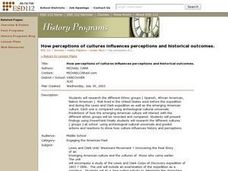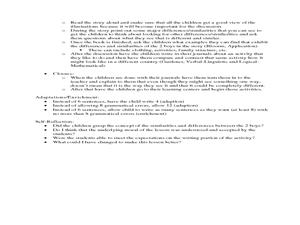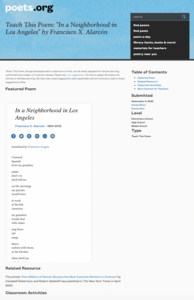Curated OER
I am Canadian
Students explore the concept of ethnicity through a survey, duscussion and a self-examination of ethnicity and diversity and what it means to them.
Curated OER
The Study of the Spanish-Speaking People of Texas: Immigration
Students identify the meaning of the following terms: immigrant, immigration, migrate, and assimilation. They identify reasons that immigrant groups came to Texas and explain where groups settle and the influence these groups have on...
Curated OER
The New Segregation
Students use census data to analyze the racial and economic diversity of their community. They discuss the role of diversity within communities and the impact that land use decisions can have on the composition of a community.
Curated OER
Molly's Pilgrim
Third graders recognize and discuss multi-ethnic nature of America's citizens through a variety of activities.
Curated OER
Issues in Public Education During the Kentucky Civil Rights Era
Students conduct oral history interviews and research historical and contemporary media articles about multiculturalism and diversity.
Curated OER
How Perceptions of Cultures Influences Perceptions and Historical Outcomes
Learners research different ethnic groups that lived in the United States. They compare and contrast Spanish, African American and Native American cultures and how American culture interacted with them. They present their findings...
Curated OER
Ethnic Art: African. Mexican and Caribbean Perspectives
Students study artistic aspects of their culture. They compare ethnic cultures through arts and crafts and produce quality works of art from the knowledge that they have gained. They develop the vocabulary required to verbalize or...
Curated OER
Diversity Geography
Ninth graders explore the diversity of people found throughout the world. In this Geography lesson plan, 9th graders create a short oral report describing that area.
Curated OER
Australia's Religious Diversity
Students identify major world religions and forms of spirituality and recognise the religious diversity of communities in Australia. They brainstorm for the definition of religion. Students brainstorm to come up with a list of religions.
Curated OER
Book: Latino Economics in the United States: Job Diversity
Learners, after reading Chapter 1 in the book, "Latino Economics in the United States: Job Diversity," write an essay that compares the cultural as well as the historical factors (experiences with jobs, discrimination, education, etc.)...
Curated OER
Multiple Viewpoints
First graders explore the concept of multiple viewpoints. In this perspective lesson, 1st graders discuss the differences and similarities found within different cultures. Students then write a narrative about how something they can do...
Teaching Tolerance
Slavery as a Form of Racialized Social Control
An engaging lesson delves into the effects of slavery on society. Young historians read text excerpts, complete handouts, and participate in group discussion to understand how slavery was a means to control society and establish a racial...
Teaching Tolerance
Talking About Race and Racism
Set the stage for discussion in a thought-provoking instructional activity on racism. An informative resource prepares scholars to discuss the history of race and racism with a quiz, vocabulary, and guidelines. Academics discuss topics...
Teaching Tolerance
Jim Crow as a Form of Racialized Social Control
Just because slavery was illegal doesn't mean it went away ... Jim Crow Laws took its place. An eye-opening lesson focuses on how Jim Crow Laws were used as a form of racial social control against African Americans in the United States....
Teaching Tolerance
Racial Disparity in the Criminal Justice System
Explore the impact of the war on drugs in a thought-provoking lesson plan for high school academics. Young historians delve into the world of the criminal justice system and the racial disparity that occurs in the US. The resource...
Teaching Tolerance
Parallels Between Mass Incarceration and Jim Crow
Is history repeating itself? A riveting lesson examines the parallels between mass incarceration in the U.S. and the Jim Crow Laws of the past. Academics review Jim Crow Laws and compare them to mass incarcerations of African Americans....
Teaching Tolerance
Why Do We (Still) Celebrate Columbus Day?
What are we really celebrating on Columbus Day? The resource explores the narrative behind Columbus Day and ways for people to change the perception. Scholars also review vocabulary terms associated with the topic and how attitudes have...
PBS
Latino Americans Share Their Experiences
Three Latino Americans are the focus of an interactive that spotlights their accomplishments. Scholars get to know Lin-Manuel Miranda, Judy Reyes, and José Hernández through short informative text and videos. Participants read, take...
Teaching Tolerance
Understanding the Prison Label
Break the chain. An engaging lesson examines why it is so hard to break free of the prison system in the US. Academics participate in a reader's theater, read primary sources, and discuss their thoughts. The lesson explains the hardships...
Anti-Defamation League
"What is it Like to be an Outsider?”: Building Empathy for the Experiences of Immigrants
This instructional activity highlights the struggles of immigrants and the importance of showing empathy. Beginning with a read-aloud of a book in another language and a poem, scholars take part in a thoughtful discussion. Then, the...
Academy of American Poets
Teach This Poem: "In a Neighborhood in Los Angeles" by Francisco X. Alarcón
After sketching an essential person and reading an article, scholars read the poem "In a Neighborhood in Los Angeles" by Francisco X. Alarcón. They listen to the poem in English and Spanish and record lines that stand out to them. Small...
Anti-Defamation League
Bellen Woodard, Identity, and “Crayon Activism”
Scholars learn about a young child turn activist and author, Bellen Woodard. Learners discuss identity, the importance of representation, and how activism makes a difference. Small groups brainstorm ways to create change and the steps to...
Facing History and Ourselves
After Charlottesville: Public Memory and the Contested Meaning of Monuments
Are Civil War monuments a kind remembrance or a reminder of a dark past? The lesson focuses on the public's memory of the Civil War and the monuments that represent it. Young academics explore past efforts to change historical symbols...
National First Ladies' Library
The Many Voices of Literature
Students discover the wealth of literature written by individuals not born in the United States. They discover the literature of individuals of multiple ethnicities born in the United States. Students compile a list of books they would...
Other popular searches
- Ethnic Diversity and Math
- Ethnic Diversity Activity
- Ethnic Diversity Africa
- Race and Ethnic Diversity
- Ethnic Diversity Kid Er
- Ethnic Diversity in Europe
- Ethnic Diversity London
- Ethnic Diversity Kinder
- Ethnic Diversity Kider

























